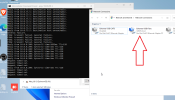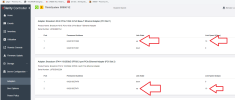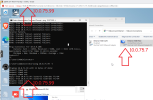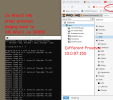"BCM57414 NetXtreme-E 10Gb/25Gb" works here on 10GB (tested with DAG and multimode 10GB)
Proxmox 8.2.2 fresh install without any additional drivers on Kernel 6.8.4-3-pve
ThinkSystem SR650 V2
Code:
Bonding Mode: fault-tolerance (active-backup)
Primary Slave: ens2f0np0 (primary_reselect always)
Currently Active Slave: ens2f0np0
MII Status: up
MII Polling Interval (ms): 100
Up Delay (ms): 0
Down Delay (ms): 0
Peer Notification Delay (ms): 0
Slave Interface: ens2f0np0
MII Status: up
Speed: 10000 Mbps
Duplex: full
Link Failure Count: 0
Permanent HW addr: 04:32:01:xx:xx:xx
Slave queue ID: 0
What is the output of "ip a"?
root@qbgw:~# ip a
1: lo: <LOOPBACK,UP,LOWER_UP> mtu 65536 qdisc noqueue state UNKNOWN group default qlen 1000
link/loopback 00:00:00:00:00:00 brd 00:00:00:00:00:00
inet 127.0.0.1/8 scope host lo
valid_lft forever preferred_lft forever
inet6 ::1/128 scope host noprefixroute
valid_lft forever preferred_lft forever
2: ens4f0: <BROADCAST,MULTICAST,UP,LOWER_UP> mtu 1500 qdisc mq master vmbr0 state UP group default qlen 1000
link/ether d4:04:e6:0f:24:b8 brd ff:ff:ff:ff:ff:ff
altname enp174s0f0
3: ens1f0np0: <BROADCAST,MULTICAST> mtu 1500 qdisc noop state DOWN group default qlen 1000
link/ether 04:32:01:d7:c0:90 brd ff:ff:ff:ff:ff:ff
altname enp216s0f0np0
4: ens4f1: <BROADCAST,MULTICAST> mtu 1500 qdisc noop state DOWN group default qlen 1000
link/ether d4:04:e6:0f:24:b9 brd ff:ff:ff:ff:ff:ff
altname enp174s0f1
5: ens4f2: <BROADCAST,MULTICAST> mtu 1500 qdisc noop state DOWN group default qlen 1000
link/ether d4:04:e6:0f:24:ba brd ff:ff:ff:ff:ff:ff
altname enp174s0f2
6: ens4f3: <BROADCAST,MULTICAST> mtu 1500 qdisc noop state DOWN group default qlen 1000
link/ether d4:04:e6:0f:24:bb brd ff:ff:ff:ff:ff:ff
altname enp174s0f3
7: ens1f1np1: <NO-CARRIER,BROADCAST,MULTICAST,UP> mtu 8600 qdisc mq master vmbr2 state DOWN group default qlen 1000
link/ether 04:32:01:d7:c0:91 brd ff:ff:ff:ff:ff:ff
altname enp216s0f1np1
8: ens2f0np0: <BROADCAST,MULTICAST> mtu 1500 qdisc noop state DOWN group default qlen 1000
link/ether 04:32:01:de:fa:f0 brd ff:ff:ff:ff:ff:ff
altname enp217s0f0np0
9: ens2f1np1: <BROADCAST,MULTICAST,UP,LOWER_UP> mtu 8900 qdisc mq master vmbr1 state UP group default qlen 1000
link/ether 04:32:01:de:fa:f1 brd ff:ff:ff:ff:ff:ff
altname enp217s0f1np1
10: vmbr0: <BROADCAST,MULTICAST,UP,LOWER_UP> mtu 1500 qdisc noqueue state UP group default qlen 1000
link/ether d4:04:e6:0f:24:b8 brd ff:ff:ff:ff:ff:ff
inet 10.0.75.99/16 scope global vmbr0
valid_lft forever preferred_lft forever
inet6 fe80::d604:e6ff:fe0f:24b8/64 scope link
valid_lft forever preferred_lft forever
11: vmbr2: <BROADCAST,MULTICAST,UP,LOWER_UP> mtu 8600 qdisc noqueue state UP group default qlen 1000
link/ether 04:32:01:d7:c0:91 brd ff:ff:ff:ff:ff:ff
inet 10.0.75.97/16 scope global vmbr2
valid_lft forever preferred_lft forever
inet6 fe80::632:1ff:fed7:c091/64 scope link
valid_lft forever preferred_lft forever
12: tap101i0: <BROADCAST,MULTICAST,PROMISC,UP,LOWER_UP> mtu 8600 qdisc pfifo_fast master fwbr101i0 state UNKNOWN group default qlen 1000
link/ether 9a:97:60:83:d2:26 brd ff:ff:ff:ff:ff:ff
13: fwbr101i0: <BROADCAST,MULTICAST,UP,LOWER_UP> mtu 8600 qdisc noqueue state UP group default qlen 1000
link/ether 3e:a3:86:1d:8e:d9 brd ff:ff:ff:ff:ff:ff
14: fwpr101p0@fwln101i0: <BROADCAST,MULTICAST,UP,LOWER_UP> mtu 8600 qdisc noqueue master vmbr2 state UP group default qlen 1000
link/ether 36:d8:13:e2:54:20 brd ff:ff:ff:ff:ff:ff
15: fwln101i0@fwpr101p0: <BROADCAST,MULTICAST,UP,LOWER_UP> mtu 8600 qdisc noqueue master fwbr101i0 state UP group default qlen 1000
link/ether 3e:a3:86:1d:8e:d9 brd ff:ff:ff:ff:ff:ff
16: vmbr1: <BROADCAST,MULTICAST,UP,LOWER_UP> mtu 1500 qdisc noqueue state UP group default qlen 1000
link/ether 04:32:01:de:fa:f1 brd ff:ff:ff:ff:ff:ff
inet 10.0.75.98/16 scope global vmbr1
valid_lft forever preferred_lft forever
inet6 fe80::632:1ff:fede:faf1/64 scope link
valid_lft forever preferred_lft forever
17: tap101i1: <BROADCAST,MULTICAST,PROMISC,UP,LOWER_UP> mtu 1500 qdisc pfifo_fast master fwbr101i1 state UNKNOWN group default qlen 1000
link/ether b2:38:43:15:6c:86 brd ff:ff:ff:ff:ff:ff
18: fwbr101i1: <BROADCAST,MULTICAST,UP,LOWER_UP> mtu 1500 qdisc noqueue state UP group default qlen 1000
link/ether 46:65:11:e3:56:c6 brd ff:ff:ff:ff:ff:ff
19: fwpr101p1@fwln101i1: <BROADCAST,MULTICAST,UP,LOWER_UP> mtu 1500 qdisc noqueue master vmbr1 state UP group default qlen 1000
link/ether f2:f5:dc:31:4a:8b brd ff:ff:ff:ff:ff:ff
20: fwln101i1@fwpr101p1: <BROADCAST,MULTICAST,UP,LOWER_UP> mtu 1500 qdisc noqueue master fwbr101i1 state UP group default qlen 1000
link/ether 46:65:11:e3:56:c6 brd ff:ff:ff:ff:ff:ff
21: tap101i2: <BROADCAST,MULTICAST,PROMISC,UP,LOWER_UP> mtu 1500 qdisc pfifo_fast master fwbr101i2 state UNKNOWN group default qlen 1000
link/ether 16:d6:15:db:0e:c6 brd ff:ff:ff:ff:ff:ff
22: fwbr101i2: <BROADCAST,MULTICAST,UP,LOWER_UP> mtu 1500 qdisc noqueue state UP group default qlen 1000
link/ether 02:3c:d7:74:81:83 brd ff:ff:ff:ff:ff:ff
23: fwpr101p2@fwln101i2: <BROADCAST,MULTICAST,UP,LOWER_UP> mtu 1500 qdisc noqueue master vmbr0 state UP group default qlen 1000
link/ether d2:57:e2:e0:07:80 brd ff:ff:ff:ff:ff:ff
24: fwln101i2@fwpr101p2: <BROADCAST,MULTICAST,UP,LOWER_UP> mtu 1500 qdisc noqueue master fwbr101i2 state UP group default qlen 1000
link/ether 02:3c:d7:74:81:83 brd ff:ff:ff:ff:ff:ff






